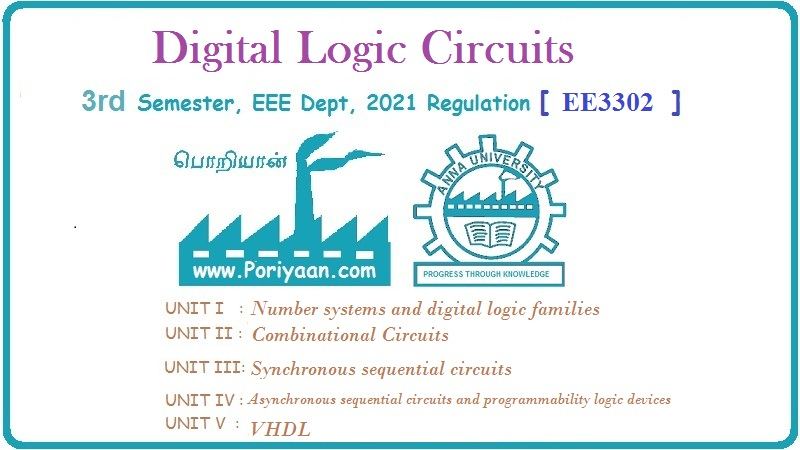Digital Logic Circuits: Unit III: (b) Analysis & Design of Synchronous Sequential Circuits
Clocked Sequential Circuits
• In synchronous or clocked sequential circuits, clocked flip-flops are used as memory elements, which change their individual states in synchronism with the periodic clock signal.
Clocked Sequential Circuits
AU
: May-05, 09, 17, Dec.-08, 11
• In synchronous or clocked sequential circuits, clocked flip-flops are used as memory elements, which change their individual states in synchronism with the periodic clock signal. Therefore, the change in states of flip-flops and change in state of the entire circuit occurs at the transition of the clock signal. The states of the output of the flip-flop in the sequential circuit gives the state of the sequential circuit.
Present
state: The status of all state variables, at some time t,
before the next clock edge, represents condition called present state.
Next
state: The status of all state variables, at some time, t1,
represents a condition called next state. The synchronous or clocked sequential
circuits are represented by two models.
•
Moore model: The output depends only on the present
state of the flip-flops.
•
Mealy model : The output depends on both the present
state of the flip-flop(s) and on the input (s).
1. Moore Model
•
As mentioned earlier, when the output of the sequential circuit depends only on
the present state of the flip-flop, the sequential circuit is referred to as
Moore model. Let us see one example of Moore model. Fig. 5.2.1 shows a
sequential circuit which consists of two JK flip-flops and AND gate. The
circuit has one input X and one output Y.
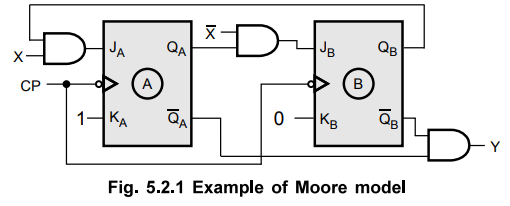
•
As shown in the Fig. 5.2.1, input is used to determine the inputs of the
flip-flops. It is not used to determine the output. The output is derived using
only present states of the flip-flops or combination of it (in this case Y = QA,
QB).

•
In general form the Moore model can be represented with its block schematic as
shown in Fig. 5.2.2 (a) and (b).
•
In the Moore model, as output depends only on present state of flip-flops, it
appears only after the clock pulse is applied, i.e. it varies in synchronism
with the clock input.
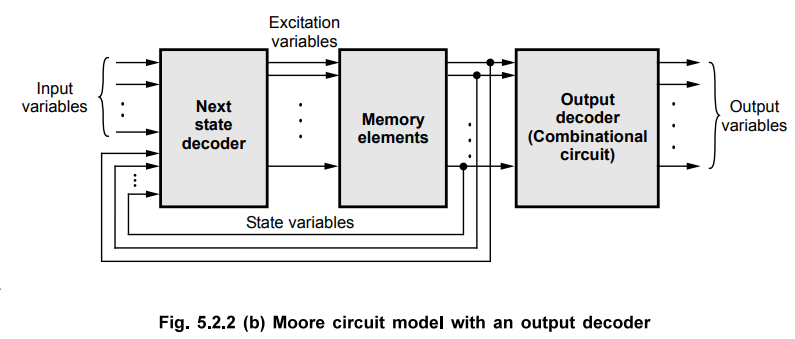
2. Mealy Model
•
When the output of the sequential circuit depends on both the present state of
flip-flop(s) and on the input(s), the sequential circuit is referred to as
Mealy model. Fig. 5.2.3 shows the sample Mealy model. As shown in the Fig.
5.2.3, the output of the circuit is derived from the combination of present
state of flip-flops and input (s) of the circuit.
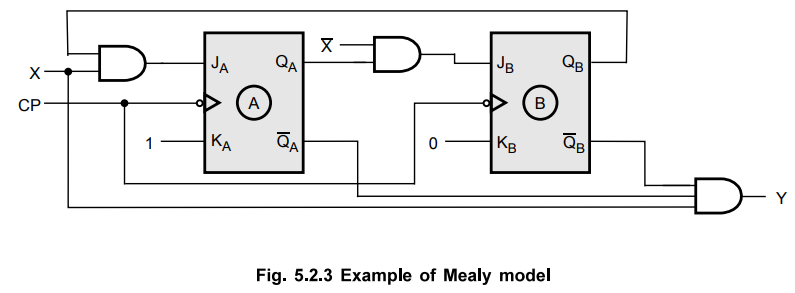
•
Looking at Fig. 5.2.3, we can easily realize that, changes in the input within
the clock pulses can not affect the state of the flip-flop. However, they can
affect the output of the circuit. Due to this, if the input variations are not
synchronized with the clock, the derived output will also not be synchronized
with the clock and we get false output (as it is a synchronous sequential
circuit). The false outputs can be eliminated by allowing input to change only
at the active transition of the clock (in our example HIGH-to-LOW). In general
form the Mealy model can be represented with its block schematic as shown in
Fig. 5.2.4.
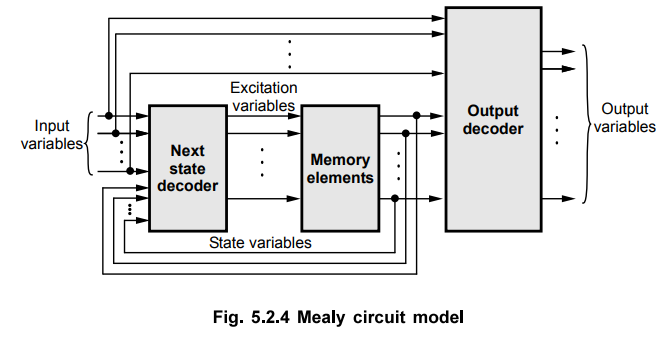
3. Moore vs Mealy Circuit Models

4. Representations of Sequential Circuits
a.
State Diagram
•
State diagram is a pictorial representation of a behaviour of a sequential
circuit. Fig. 5.2.5 shows a state diagram. The state is represented by the
circle, and the transition between states is indicated by directed lines
connecting the circles. A directed line connecting a circle with itself
indicates that next state is same as present state. The binary number inside
each circle identifies the state represented by the circle. The directed lines
are labelled with two binary numbers separated by a symbol '/'. The input value
that causes the state transition is labelled first and the output value during
the present state is labelled after the symbol '/'.

•
In case of Moore circuit, the directed lines are labelled with only one binary
number representing the state of the input that causes the state transition.
The output state is indicated within the circle, below the present state
because output state depends only on present state and not on the input. Fig.
5.2.6 shows the state diagram for Moore circuit.
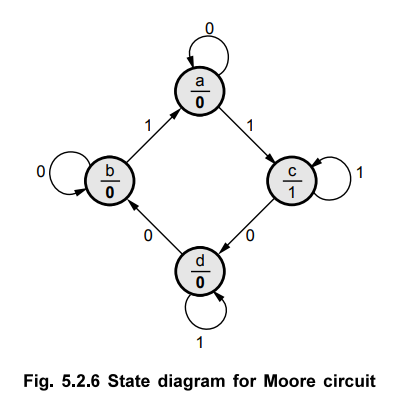
b.
State Table
•
Although the state diagram provides a description of the behaviour of a
sequential circuit that is easy to understand, to proceed with the
implementation of the circuit, it is convenient to translate the information
contained in the state diagram into a tabular form called state synthesis table
or simply state table. Table 5.2.2 (a) shows the state table for the state
diagram shown in Fig. 5.2.5. It represents relationship between input, output
and flip-flop states. It consists of three sections labeled present state, next
state, and output. The present state designates the state of flip-flops before
the occurrence of a clock pulse. The next state is state of the flip-flop after
the application of a clock pulse, and the output section gives the values of
the output variables during the present state. Both the next state and output
sections have two columns representing two possible input conditions : X = 0
and X = 1.

•
In case of Moore circuit the output section has only one column since output
does not depend on input. The Table 5.2.2 (b) shows the state table for Moore
circuit whose state diagram is shown in Fig. 5.2.6.
c.
Transition Table
•
A transition table takes the state table one step further. The state diagram
and state table represent state using symbols or names. In the transition table
specific state variable values are assigned to each state. Assignment of values
to state variables is called State assignment. Like state table transition
table also represents relationship between input, output and flip-flop states.
The Fig. 5.2.7 shows the transition table.

•
Here, AB are the state variables. The AB = 00 represents one state, AB = 01
represents second state and so on.
Review Questions
1. What is a state?
AU ; May-09, Marks 2
2. Define present state and next state.
3. Draw and explain the block diagram of Moore model.
4. Draw and explain the block diagram of Mealy model.
5. What is a Mealy machine ? Give an example.
AU : May-05, Dec.-08, Marks 2
6. Compare Moore and Mealy circuits.
AU ; May-05, Marks
7. What is state diagram ? Explain with the help of example.
8. What is state table ? Explain with the help of example.
9. What is transition table ?
10. How does the state transition diagram of a Moore model
differ from Mealy model ?
AU : Dec.-ll, Marks 2
Digital Logic Circuits: Unit III: (b) Analysis & Design of Synchronous Sequential Circuits : Tag: : - Clocked Sequential Circuits
Related Topics
Related Subjects
Digital Logic Circuits
EE3302 3rd Semester EEE Dept | 2021 Regulation | 3rd Semester EEE Dept 2021 Regulation
